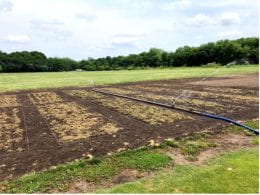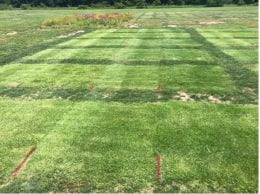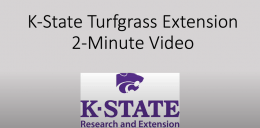 The option for spring seeding is approaching. Cool-season grasses may have been seeded in the winter months, or can be seeded in spring – preferably in March and April in Kansas. Cool-season seed germination typically starts when the soil temperature reaches 50 F. Of course, fall seeding is preferred, but we are often dealing with situations where turf quality needs to be improved with spring seeding. One of the difficult problems is dealing with the emergence of summer annual weeds as the desired turfgrass species you’ve seeded begins to emerge. Here are herbicides that can be applied at the time of seeding to suppress summer annuals:
The option for spring seeding is approaching. Cool-season grasses may have been seeded in the winter months, or can be seeded in spring – preferably in March and April in Kansas. Cool-season seed germination typically starts when the soil temperature reaches 50 F. Of course, fall seeding is preferred, but we are often dealing with situations where turf quality needs to be improved with spring seeding. One of the difficult problems is dealing with the emergence of summer annual weeds as the desired turfgrass species you’ve seeded begins to emerge. Here are herbicides that can be applied at the time of seeding to suppress summer annuals:
Tupersan (active ingredient siduron)
Siduron is a preemergence herbicide that can be used on cool-season grasses. It does provide weed suppression, but don’t expect the same level of weed control that we get with products that are commonly used on fully established turf. It is approved for used on colonial bentgrass, creeping bentgrass, Kentucky bluegrass, perennial ryegrass, tall fescue. To view a Tupersan label, CLICK HERE
Tenacity (active ingredient meotrione)
Mesotrione inhibits photosynthesis in weeds once absorbed by shoots or roots. It originated based upon biochemicals observed in the plant called bottlebrush (Callistemon citrinus). It suppresses weeds as they absorb the herbicide at time of emergence and can also be used as a postemergence product. Midwest grasses for which it is labeled include buffalograss, Chewings fescue, creeping red fescue, hard fescue, Kentucky bluegrass, perennial ryegrass, and tall fescue. To view a Tenacity label, CLICK HERE
A number of other herbicides can be used once turfgrass reaches a point of maturity after seeding. Find more details about postemergence herbicides that can be used after seeding, and all information about turf weed by getting a copy of the 2022 edition of Turfgrass Weed Control for Professionals

Find more information on weed control by clicking on the tags on the blog (left column), such as “weed control,” “crabgrass,” etc., or search by category on the right side of the page.
***Mention of trade names or commercial products in this article is solely for identification purposes and does not imply recommendation or endorsement, nor is criticism implied of similar products not mentioned by Kansas State University.***






